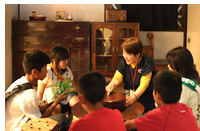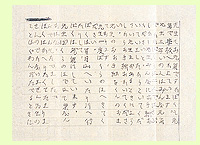| |


|
|
 |
 |
The Fifteen-Year War was an all-out battle to which Japan devoted all of its resources. The nation needed not only the power of its military forces on the battlefield, but also the cooperation of the citizens left behind. After its armed forces were sent off to the front, the country mobilized its women, youth, students and children to carry out support work. A number of organizations were formed to ensure cooperation with the war effort, and people were pressured not to complain or protest. A wide range of materials was also confiscated for military purposes.
|
 |
As the war in China intensified, the government pressured people to join new types of organizations such as the "National Spirit" General
Mobilization Movement. In addition to such psychological pressure to support
the war effort, the government gradually began to strengthen measures to ensure
economic cooperation as well . Civilians were forced to lead an increasingly frugal
lifestyle and wear "national uniforms" instead of normal civilian clothing.
Later, even stricter measures were enforced, and the rationing of staples began.
Cultural activities were also controlled, and it became difficult to create or
produce dramas unless they supported the war. Primary schools began to be called "national schools", and education was increasingly militaristic. . Civilians were forced to lead an increasingly frugal
lifestyle and wear "national uniforms" instead of normal civilian clothing.
Later, even stricter measures were enforced, and the rationing of staples began.
Cultural activities were also controlled, and it became difficult to create or
produce dramas unless they supported the war. Primary schools began to be called "national schools", and education was increasingly militaristic.
|
 |
Once the Fifteen-Year War had begun, Japan's military regime increasingly restricted freedom of speech and academic pursuits by universities. As the conflict became more intense, college students had to stop studying and were sent to work in munitions factories. In the last stages of the War, many were drafted and sent to the front before they had a chance to graduate.
Ritsumeikan University was deeply affected by the War and adopted a nationalistic curriculum as early as the 1920s. In 1928, the university established the Kin'eitai, a special armed unit of Ritsumeikan students who served as Imperial Guards, in order to take part in the coronation ceremony of Emperor Hirohito. In 1943, the university even established
a system for the university to take part in the final battle of the war under the leadership of the Kin'eitai.
|
| |

Replica of a portion of a typical Japanese townhouse during the war |
|
|
| |
 Letter
Written by a Child Evacuee Letter
Written by a Child Evacuee |
|
 Letter written by a child evacuee to his teacher, saying things like “Please write me a letter when you have the time”and “I want to go home so bad I can’t stand it.” (Part of the Kyoto Museum for World
Peace collection) Letter written by a child evacuee to his teacher, saying things like “Please write me a letter when you have the time”and “I want to go home so bad I can’t stand it.” (Part of the Kyoto Museum for World
Peace collection)
|
|
|
| |
|
|
|
 |
|
|
|